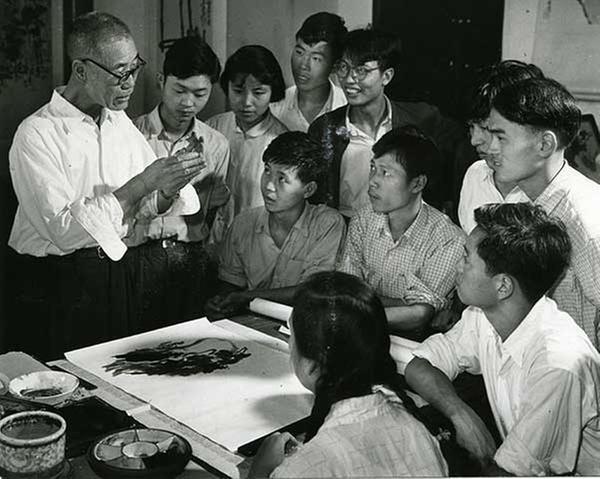Savior of a genre
By Lin Qi | China Daily | Updated: 2017-05-09 07:19
 |
| Pan Tianshou instructs students of the ink painting department of the China Academy of Art in 1963.[Photo provided to China Daily] |
One is inscribed with "always be overwhelming" and the other with "stand upright".
"He meant that creators of Chinese culture should be confident, assertive and independent," Xu says.
"He said that Chinese and Western art were two peaks that stood apart yet could interact with each other."
The exhibition's works exemplify his endeavors to enhance a fearless, noble spirit of Chinese painting, which was waning after the Song Dynasty (960-1279).
Pan Tianshou revisited the motifs of rocks - which often take up more than one-third of his compositions - tenacious pine trees with twisted branches and ferocious eagles.
He softened the rigidness of these subjects by adding colorful clusters of wild grass on the ground and blossoming flowers on the treetops.
A fine specimen of this is Everlasting Glory, a 6-meter-long piece Pan Tianshou created in 1964 for the celebrations of the 15th anniversary of New China's founding.
It's his largest work and the centerpiece of the exhibition. It depicts three eagles standing on a huge rock and another one resting in a pine tree.
His distinctive approach saved the flower-and-bird genre as it was being abandoned by mainstream aesthetics in the 1950s. The genre was then criticized for embracing a scholarly style of self-enjoyment and lacking grand momentum. Some even said it would someday be replaced by oil painting.
Pan Tianshou reformed the genre to return it to the general public's attention.
In his book, History of Chinese Painting, he wrote: "There are people who, when they see novel things from a different culture, give up their own culture entirely and worship the new one.
























